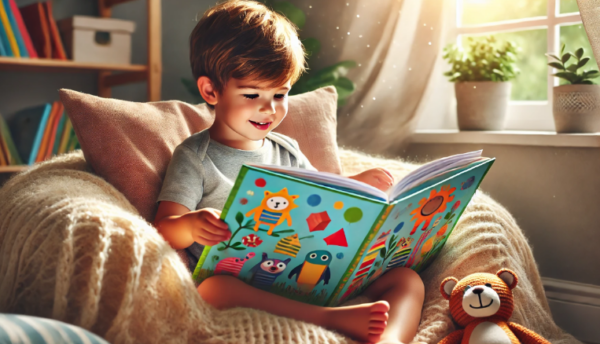Every great children’s book starts with a spark—an idea that inspires smiles stirs imaginations, or warms hearts. Whether you’re a parent weaving bedtime stories, a teacher eager to inspire young minds, or a writer with a dream, creating a children’s book is one of the most rewarding ways to make a difference in the lives of young readers. But while dreaming up a magical story may come naturally, navigating the publishing process often feels overwhelming.
For a children’s book author, the journey is filled with unique challenges and rewards, from understanding the young audience to creating engaging illustrations and compelling narratives.
Enter self-publishing: a flexible, empowering, and increasingly popular way for aspiring authors to bring their stories to life. In 2024, platforms like Spines are making it easier than ever to transform your ideas into beautifully crafted books that captivate children and parents alike. With creative freedom, straightforward tools, and a supportive community, self-publishing isn’t just a viable option—it’s the best path for authors looking to share their stories with the world.
If you’ve ever imagined holding your own book in your hands, seeing your illustrations come to life, or knowing your words are reaching a young audience, this guide will show you how to make it happen. Let’s explore the easiest way to self-publish your children’s book and why Spines is the perfect partner for your publishing journey.
Why Self-Publishing is the Best Path for Children’s Book Authors
Creative Freedom Meets Modern Publishing
Traditional publishing often means surrendering control over your work. A publisher might tweak your story, alter your illustrations, or even determine whether your book fits their lineup at all. In contrast, self-publishing empowers children’s book authors to stay true to their vision.
Your Publishing Journey Awaits – Start NowWith self-publishing platforms like Spines, you decide everything—from your book’s story and design to its marketing and sales strategy. Whether you’re creating a vibrant picture book for preschoolers or a heartfelt story for older kids, self-publishing lets you maintain the heart of your work. The shift from traditional publishing to independent publishing offers unique opportunities and creative freedom, allowing children’s book authors to produce and distribute their work while tailoring their marketing strategies to target specific audiences effectively.
Self-publishing also eliminates the barriers often associated with traditional publishers: long waiting times, high rejection rates, and limited opportunities for new authors. Platforms like Spines are tailored for indie authors, making the publishing process straightforward and accessible.
The Essentials of Writing and Preparing Your Children’s Book
From Idea to Eye-Catching Cover: Steps to Create Your Book
Creating a children’s book involves more than just putting words on a page—it’s about crafting an experience. Start by writing a story that resonates with your target audience. Whether your readers are curious preschoolers or adventurous grade-schoolers, focus on themes, characters, and language they’ll relate to. In today’s market, children’s books that address themes of diversity and notable historical figures are increasingly popular.
Next, think about illustrations. For picture books, captivating visuals are just as important as the story. Understanding the nuances of children’s literature is crucial when creating a children’s book. If you’re not an artist, Spines connects you with talented illustrators who can bring your vision to life. You’ll also need to choose the right trim size (the dimensions of your book) and design an eye-catching cover that grabs attention.
Editing is crucial. A polished manuscript ensures your story flows seamlessly and connects with readers. Spines offers professional editing tools to help refine your work before publishing.
Creating Engaging Illustrations and Design
Creating engaging illustrations and designs is crucial for capturing the imagination of young readers. The visual elements of a children’s book are just as important as the story itself, as they help bring the narrative to life and keep children engaged. Here are some tips to ensure your illustrations and design stand out:
When it comes to illustrations:
- Use Bright, Bold Colors: Young readers are naturally drawn to vibrant colors. Use a palette that captures their attention and complements the story.
- Incorporate Textures and Patterns: Adding textures and patterns can give your illustrations depth and make them more interesting.
- Maintain Consistency: Ensure that the style of your illustrations is consistent throughout the book. This helps create a cohesive and professional look.
- Visual Rhythm: Use illustrations to break up the text and create a sense of rhythm. This keeps the reader’s eye moving and makes the book more engaging.
For the design of your book:
- Choose Readable Fonts: Select fonts that are easy to read and appropriate for the age group of your target audience. Clear typography is essential for young readers.
- Use Headings and Subheadings: Break up the text with headings and subheadings to create a clear hierarchy of information. This makes the book easier to navigate.
- Organize the Layout: A well-organized layout ensures that the story flows smoothly. Pay attention to the placement of text and images to create a balanced design.
- Effective Use of White Space: White space helps to avoid clutter and makes the book more visually appealing. It also gives the reader’s eyes a place to rest.
By focusing on engaging illustrations and thoughtful design, you can create a children’s book that not only tells a great story but also captivates young readers visually.
Formatting and Printing Options for Self-Publishing
When self-publishing a children’s book, choosing the right formatting and printing options is crucial to ensure your book looks professional and reaches your audience effectively. Here are some options to consider:
- Print-on-Demand (POD) Services: POD services allow you to print books as they are ordered, eliminating the need for large upfront investments and storage. This is ideal for self-published authors who want to manage costs and avoid holding inventory. POD services also often include distribution channels, making it easier to get your book into the hands of readers.
- Offset Printing: This traditional printing method involves printing a large quantity of books at once. While it requires a larger upfront investment, offset printing typically offers higher quality and lower per-unit costs for large print runs. This option is suitable for authors who plan to sell books through their own website, at events, or in bulk to retailers.
- E-book Formatting: Creating an e-book version of your children’s book allows you to reach a digital audience. This involves converting your book into a digital format and optimizing it for e-readers and tablets. E-books can be sold on platforms like Amazon Kindle, making them accessible to a global audience.
When choosing a printing option, consider the following factors:
- Cost: POD services have lower upfront costs, making them accessible for new authors. Offset printing, while more expensive initially, can be more cost-effective for large print runs.
- Quality: Offset printing generally produces higher-quality books, but POD services have improved significantly and can offer good quality as well.
- Distribution: POD services often include built-in distribution channels, simplifying the process of getting your book to readers. With offset printing, you will need to handle distribution yourself.
By carefully considering your options, you can select the best formatting and printing method for your self-published children’s book, ensuring it meets your quality standards and budget.
How Spines Makes Self-Publishing Easy and Affordable
Why Spines is the Best Choice for Children’s Book Authors
Spines stands out as a one-stop platform designed specifically for authors like you. It offers everything you need to turn your manuscript into a finished product, whether it’s a printed book or an ebook. With print-on-demand services, you can publish without worrying about upfront costs or storing inventory—books are printed only when ordered.
Spines also simplifies the publishing process with user-friendly tools that guide you through formatting, cover design, and distribution. You can sell your book online or in physical stores, reaching readers worldwide. Plus, Spines offers marketing support to help you connect with the right audience. Spines supports the journey of a self-published author by providing essential resources and services, making it easier to get your books into bookstores and reach a wider audience.
Authors using Spines often praise its affordability and efficiency. Many have transitioned from struggling with traditional publishers to becoming successful indie authors, thanks to Spines’ streamlined approach.
Comparing Self-Publishing vs. Traditional Publishing
Tradition vs. Independence: Choosing the Right Path
Traditional publishing might seem like the gold standard, but it’s not always the best fit—especially for children’s book authors. While a traditional publisher handles many aspects of the publishing process, they often leave authors with limited input and lower royalties.
Your Publishing Journey Awaits – Start NowIn contrast, self-publishing allows for complete independence. You can work on your own timeline, keep a larger share of your profits, and maintain creative control. While traditional publishing may offer prestige and a structured process with professional support, self-publishing with Spines offers freedom and the ability to connect directly with readers.
A traditionally published author benefits from having a publisher handle the production aspects of a book, such as hiring editors and designers, as well as managing financial aspects like royalty earnings. However, self-published authors enjoy the experience of retaining full creative control and making all publishing decisions themselves.
Budgeting and Financial Planning for Self-Publishing
Self-publishing a children’s book is an exciting journey, but it requires careful budgeting and financial planning to ensure success. Here are some tips to help you manage your finances effectively:
- Determine Your Budget: Start by deciding how much you are willing to spend on your self-publishing project. Consider all potential costs, including editing, illustration, design, printing, and marketing. Having a clear budget will help you make informed decisions and avoid overspending.
- Prioritize Your Spending: Allocate your budget to the most critical aspects of your project. For example, if you are creating a picture book, you might want to invest more in high-quality illustrations and professional design. Prioritizing your spending ensures that the most important elements of your book receive the attention they need.
- Consider Crowdfunding: If you find it challenging to fund your project, consider using a crowdfunding platform like Kickstarter or Indiegogo. These platforms allow you to raise money from supporters who believe in your project. Successful crowdfunding campaigns can provide the financial boost you need to bring your book to life.
- Plan for Ongoing Expenses: Remember that self-publishing is an ongoing process. You will need to budget for continuous expenses such as marketing, distribution, and potential reprints. Planning for these costs ensures that you can sustain your efforts and continue to promote your book effectively.
By creating a detailed budget and financial plan, you can manage your self-publishing project efficiently, ensuring that you stay on track and achieve your goals without financial stress.
Distribution and Sales Channels
Once your children’s book is published, the next step is to distribute it to your target audience. Here are some effective distribution and sales channels to consider:
- Online Retailers: Platforms like Amazon, Barnes & Noble, and other online retailers can help you reach a wide audience. Listing your book on these sites makes it accessible to readers worldwide and can significantly boost your sales.
- Bookstores: Partnering with local and independent bookstores can increase your book’s visibility in your community. Approach bookstore owners with a professional pitch and offer to host book signings or reading events to attract customers.
- Author Website: Creating a dedicated website for your book allows you to sell directly to readers. Your website can also serve as a hub for information about your book, upcoming events, and your author’s journey. Use it to build a mailing list and engage with your audience.
- Social Media: Utilize social media platforms like Facebook, Instagram, and Twitter to promote your book. Share engaging content, such as behind-the-scenes looks at your writing process, illustrations, and reader reviews. Social media is a powerful tool for connecting with potential readers and building a loyal following.
- Book Festivals and Events: Attend book festivals, fairs, and other literary events to showcase your book. These events provide opportunities to meet readers, network with other authors, and gain exposure. Consider hosting readings or workshops to engage with your audience directly.
By leveraging multiple distribution and sales channels, you can increase your book’s visibility and reach a broader audience. Each channel offers unique opportunities to connect with readers and promote your children’s book effectively.
Marketing and Selling Your Self-Published Children’s Book
Reaching Young Readers: How to Market Your Book
Once your book is published, it’s time to market it. Start by identifying your audience—parents, teachers, and librarians are key buyers of children’s books. Use social media to showcase your book and connect with readers.
Spines offers tools to help you distribute your book online, list it on major retail platforms, and promote it in local libraries or schools. You can also attend book fairs, host reading events, and collaborate with educators to expand your reach.
How to Turn Your Children’s Book into a Career
From First Book to Six Figures: Building Your Author Brand
Publishing your first children’s book is just the beginning. With dedication, you can grow into a successful author by consistently creating engaging stories, building your audience, and exploring new opportunities.
Many self-published authors find success by expanding their portfolio, writing books in the same genre, or experimenting with new themes. By partnering with Spines, you’ll have access to tools and resources that help you sustain and scale your author journey.
Conclusion: Your Story Deserves to Be Shared
Writing a children’s book is a labor of love, and every great story deserves a chance to find its audience. In 2024, self-publishing has revolutionized the way authors share their work, making it easier than ever to turn your dream into reality. Platforms like Spines are leading the charge, offering creative freedom, affordable solutions, and invaluable support for indie authors.
So, what are you waiting for? Your story could be the next favorite bedtime tale or classroom read-aloud. Take the first step, choose Spines, and let your imagination take flight. The world of children’s literature is waiting for your voice—now is the time to share it.
Your Publishing Journey Awaits – Start Now







